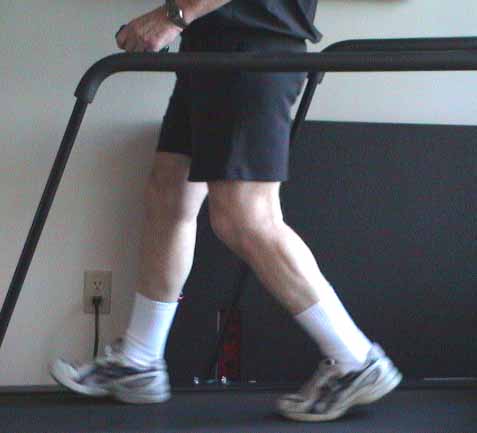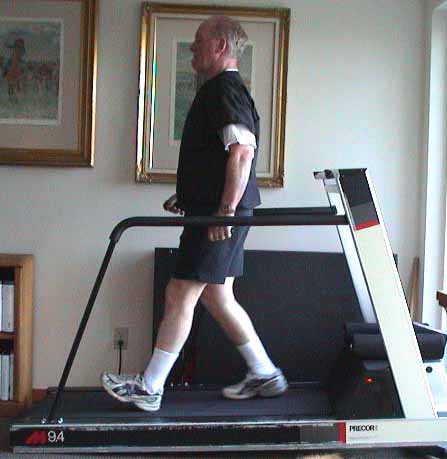RETRO WALKING FOR REHABILITATION AND FITNESS
Barry T. Bates, Ph.D. |
 |
Introduction
Injury is never pleasant for the professional athlete, the weekend athlete, or anyone participating in an exercise program for improved fitness and overall good health. However, when such a misfortune occurs, one typically has to spend some time rehabilitating the injured tissues and/or systems which suffered the over-stress. Not only is injury a concern, but prevention of injury is also an issue, especially as one grows older.
The purpose of this article is to overview the modality of backward walking as a component of the rehabilitation program for many lower extremity injuries and/or for injury prevention. In so doing, we will identify the salient features of backward walking from a rehabilitation perspective, and also suggest an exercise routine to incorporate which may be of benefit for many active individuals.
Primary Benefits / Differences
Backward walking, like forward walking, is an activity in which one always maintains contact with the ground (unlike running, which has an airborne phase). Consequently, the force to the body at impact is minimal in walking compared to jogging or running. This alone can be a benefit if one is suffering from an impact-type injury which could manifest as a sore knee, stress fracture, or similar problem. To this end, walking (forward or backward) could be a means to maintain cardiovascular fitness without risking further force-related trauma to the lower extremities.
The kinematics, or patterns, of walking forward are somewhat different than those of walking backward. Some of the differences can be observed visually, while others (activation patterns of muscles; specific joint angle differences) have been quantified scientifically. We will synthesize the information that we have learned in the laboratory in order to make it more practical for general understanding.
We can summarize the differences between forward and backward walking as follows:
 |
prior to loading |
Discussion
The implications of the differences between forward and backward locomotion are of primary importance in understanding any given exercise routine. As stated previously, backward walking reduces significantly the "impact" force upon contact, due to the reduced stride length, foot contact pattern, and lower extremity kinematic pattern (see Arata, High Speed Backward Running for further detail). As well, range of motion at the knee joint is reduced during backward walking incorporating a nearly isometric pattern following contact compared to a more stressful eccentric loading. This can be especially advantageous for rehabilitation of knee joint injuries. In addition during backward walking, the hamstrings (muscles along the back of the thigh) are stretched prior to activation in thigh reversal and contact due to hip flexion. Given this pre-stretch, any additional load, as is introduced during weight bearing / backward walking, is in the form of an added load / stretch upon the muscle group, which can be helpful in both rehabilitation and training scenarios.
A simple exercise routine developed by the authors that has benefitted many older adults is as follows. Two individuals work together as a team. They stand facing each other and hold each other's hands. As one person walks backward, the other walks forward. The coupling of the two individuals by holding hands assists with balance and the person walking forward serves as the "eyes" for both individuals. Both of these aspects provide an added degree of comfort/confidence especially during the initial exercise periods. The walk can be of any reasonable length, but short to moderate distances enhance the exercise by requiring more changes of direction for the pair.
A more complex variation of this exercise concept combines static balance in addition to the forward and backward walking pattern. It consists of both forward and backward walking to gain the proprioceptive advantages, but also utilizes additional balance practice to assist in overall rehabilitation advantages. The exercise is simple in description and action complex in potential benefits. The exercise regime is as follows:
1) Walk forward five steps
2) Balance briefly on the support leg as the swing leg is reversed
3) Walk backward four steps
4) Balance briefly on the support leg as the swing leg is reversed
5) Repeat
Note: The balance phase during each body reversal should be 3 to 5 seconds in length
This exercise incorporates the advantages of forward walking, backward walking and balance/proprioception. During this "5-4" walking pattern combined with a balance phase, the neuromuscular system can be exercised to its perceived fullest by incorporating dynamic gait (forward and backward) as well as static postural control on alternating legs. This exercise can be done initially with the use of hand rails and eventually without the support of rails in a demonstration of full system (body) control. One of the many potential benefits of this "5-4" routine as the nervous system is "exercised" and balance improves is the potential prevention of falls.
"5-4" as a Rehabilitative Activity
Worldwide, 1.7 million people with osteoporosis were documented to have suffered broken hips in 1990. This number is expected to increase to 6.3 million by 2050 (Associated Press, November 2000). In the U.S. alone, it is estimated that 250,000 people experience hip fractures each year due to falls. These data illustrate the serious nature of both osteoporosis and balance control. "5-4" may be an important intervention to address these problems, and others.
"5-4" is a newly introduced exercise intervention, however, feedback on its use has been extremely positive, as well as diverse in nature. Reported anecdotal benefits include enhanced whole-body (global) balance and control, including spinal column alignment. Lower extremity articular musculature, especially that of the ankle joint, is perceived to be strengthened. Stimulation of the circulatory system as a result of general movement (exercise) has also been noted. All of these reported benefits could address the problems associated with osteoporosis and falls, as previously identified.
Summary
An overview of the advantages of backward walking has been presented, with a focus on rehabilitative applications. Advantages include reduced ground reaction forces at contact, limited range of motion at the knee joint (advantageous during knee injury rehabilitation), augmented stretch of the hamstrings muscle group during the stride and the potential of proprioceptive / balance control training during activity. For these reasons, we suggest backward walking as an additional component to an intervention / rehabilitation program as well as an augmentation to an overall fitness program.
Link selections:
or